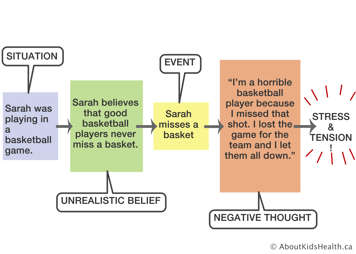Helpful thoughts lead to good feelings such as joy, hope, excitement and determination. These thoughts can help you feel less stress and tension.
Here are some examples of helpful thoughts:
- I’m really good at biology.
- I'm not a great guitar player but I sure have fun playing!
- I can manage this flare in my arthritis.
Unhelpful thoughts can cause negative feelings and emotions. These thoughts can also lead to a lot of stress and tension. Here are some examples of unhelpful thoughts:
- I won’t do well on the next math test.
- I can’t finish this project on time!
- This flare will never stop.
Everyone has unhelpful thoughts that come and go in their mind. Usually these thoughts do not lead to any problems. However, when you develop a habit of unhelpful ways of thinking about situations, bad feelings can develop. Can you imagine having unhelpful thoughts in your mind all day? It would be very hard to feel good.
Catastrophizing
One type of unhelpful thinking that is known to have a big influence on pain and stress is called “catastrophizing.” A catastrophe is a disaster or something horrible, like a shipwreck or earthquake that kills many people. But catastrophizing is when we tend to unrealistically think that something really bad or horrible has happened or will happen.
Here is an example of how some young people may have catastrophizing thoughts:
Carrie studied all week for a chemistry test. When she got her test back a week later, she saw that her mark was 70%. This was the lowest mark she had ever gotten. As she stared at her test she thought:
“I can’t believe I got this mark! I studied so hard, and none of it paid off! I’m going to fail the class and never get into university! My parents will hate me! My life is over!”
Carrie turned a fairly small negative event (a not-so-great mark on one test) into a catastrophe ("My life is over!")
Have you ever catastrophized about something?
Later in this section, you will learn about ways to help identify and manage your unhelpful thoughts. This will help you learn how to maintain or restore positive feelings through changing your thinking habits.
Realistic versus unrealistic beliefs
An unrealistic belief is something that you may think is true, but it actually is not. These unrealistic beliefs can then lead to unhelpful thoughts and stress. They can increase your pain and other symptoms.
Here’s an example:

In this example, the unrealistic belief caused the unhelpful thoughts. The belief that good basketball players never miss a shot is clearly wrong or unrealistic. All basketball players, even the very best in the world, miss a shot once in a while. If these types of unhelpful thoughts are allowed to build, bad feelings of stress and tension may arise. However, unrealistic beliefs can be challenged and turned into more realistic and helpful beliefs. This can help to make you feel good about yourself.
In the next section, we will discuss some of the ways to change your unhelpful thoughts and beliefs into helpful ones.






